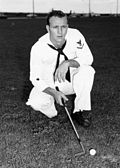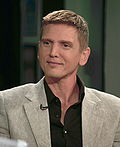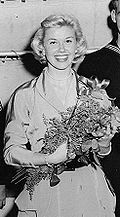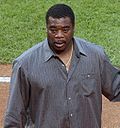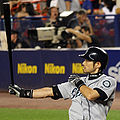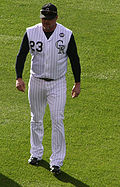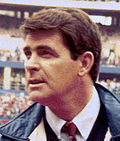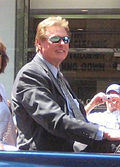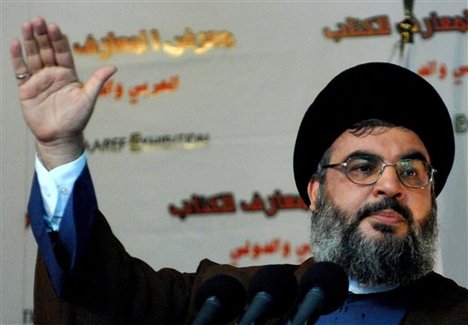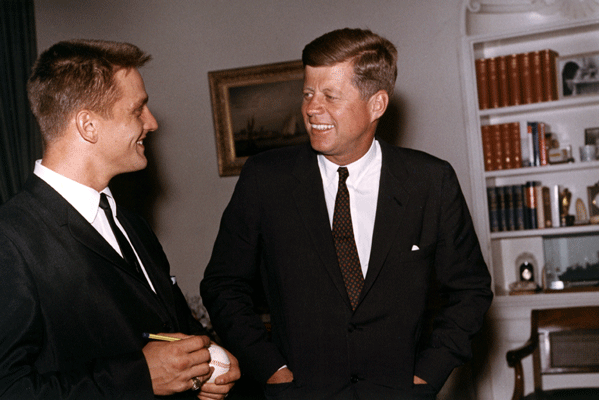| Mickey Mantle |

Mantle in 1953 |
| Center fielder |
Born: (1931-10-20)October 20, 1931
Spavinaw, Oklahoma |
Died: August 13, 1995(1995-08-13) (aged 63)
Dallas, Texas |
| Batted: Switch |
Threw: Right |
| MLB debut |
| April 17, 1951 for the New York Yankees |
| Last MLB appearance |
| September 28, 1968 for the New York Yankees |
| Career statistics |
| Batting average |
.298 |
| Home runs |
536 |
| Hits |
2,415 |
| Runs batted in |
1,509 |
| Teams |
|
|
| Career highlights and awards |
- 20× All-Star (1952, 1953, 1954, 1955, 1956, 1957, 1958, 1959, 1959², 1960, 1960², 1961, 1961², 1962, 1962², 1963, 1964, 1965, 1967, 1968)
- 7× World Series champion (1951, 1952, 1953, 1956, 1958, 1961, 1962)
- 3× AL MVP (1956, 1957, 1962)
- Gold Glove Award winner (1962)
- 1965 Hutch Award
- 1956 Triple Crown
- New York Yankees #7 retired
- Major League Baseball All-Century Team
|
| Member of the National |
   Baseball Hall of Fame Baseball Hall of Fame    |
| Induction |
1974 |
| Vote |
88.2% (first ballot) |
Mickey Charles Mantle (October 20, 1931 – August 13, 1995) was an American baseball center fielder who played 18 seasons in Major League Baseball (MLB) for the New York Yankees from 1951 to 1968. Mantle is regarded by many to be the greatest switch hitter of all time,[1] and one of the greatest players in baseball history. Mantle was inducted into the National Baseball Hall of Fame in 1974 [2] and was elected to the Major League Baseball All-Century Team in 1999.
Mantle was noted for his hitting ability, both for average and for power.[citation needed] He won the Triple Crown in 1956, leading MLB in batting average, home runs, and runs batted in (RBI).[3] He received three American League (AL) Most Valuable Player (MVP) Awards and played in twenty All-Star games. Mantle appeared in 12 World Series, winning 7 of them. He holds the records for most World Series home runs (18), RBIs (40), runs (42), walks (43), extra-base hits (26), and total bases (123).[4] He is also the career leader in walk-off home runs, with a combined thirteen, twelve in the regular season and one in the postseason.
Mickey Mantle was born in Spavinaw, Oklahoma, the son of Elvin Charles Mantle, a lead miner known as "Mutt," and Lovell (née Richardson) Mantle.[5] He was of at least partial English ancestry; his great-grandfather, George Mantle, left Brierley Hill, in England's Black Country, in 1848.[6]
Mutt named his son in honor of Mickey Cochrane, the Hall of Fame catcher.[5] Later in his life, Mantle expressed relief that his father had not known Cochrane's true first name, as he would have hated to be named Gordon.[7] Mantle spoke warmly of his father, and said he was the bravest man he ever knew. "No boy ever loved his father more," he said. Mickey would use his natural right-handed swing against his left-handed father and then turn around and bat left-handed against his right-handed grandfather. His father died of Hodgkin's disease in 1952 at the age of 39, just as his son was starting his career.
When Mantle was four years old, the family moved to the nearby town of Commerce, Oklahoma, where his father worked in lead and zinc mines.[5] As a teenager, Mantle rooted for the St. Louis Cardinals.[8] Mantle was an all-around athlete at Commerce High School, playing basketball as well as football (he was offered a football scholarship by the University of Oklahoma) in addition to his first love, baseball. His football playing nearly ended his athletic career, and indeed his life. Kicked in the shin during a game, Mantle's leg soon became infected with osteomyelitis, a crippling disease that would have been incurable just a few years earlier. A midnight drive to Tulsa, Oklahoma, enabled Mantle to be treated with newly available penicillin, saving his leg from amputation.[5] Additionally, Mantle's osteomyelitic condition exempted him from military service, which caused him to become very unpopular with fans early on, who doubtless reasoned that a person who was physically fit to play baseball was sufficiently fit to serve in the military, particularly when it was observed that he was selected as an All-Star in the same year that his "medical exemption" had been given.[citation needed]
Mantle began his professional career with the semi-professional Baxter Springs Whiz Kids.[5] In 1948, Yankees' scout Tom Greenwade came to Baxter Springs to watch Mantle's teammate, third baseman Billy Johnson. During the game, Mantle hit three home runs. Greenwade returned in 1949, after Mantle's high school graduation, to sign Mantle to a minor league contract. Mantle signed for $140 per month ($1,367 today) with a $1,500 ($14,652 today) signing bonus.[5]
Mantle was assigned to the Yankees' Class-D Independence Yankees of the Kansas–Oklahoma–Missouri League,[9] where he played shortstop.[5] During a slump, Mantle called his father to tell him he wanted to quit baseball. Mutt drove to Independence and convinced Mantle to keep playing baseball.[5] Mantle hit .313 for the Independence Yankees.[5][9]
In 1950, Mantle was promoted to the Class-C Joplin Miners of the Western Association.[9] Mantle won the Western Association batting title, with a .383 average. He also hit 26 home runs and recorded 136 runs batted in.[5] However, Mantle struggled defensively at shortstop.[5]
Mantle was invited to the Yankees instructional camp before the 1951 season. After an impressive spring training, Yankees manager Casey Stengel decided to promote Mantle to the majors as a right fielder instead of sending him to the minors.[5]
"He's the greatest prospect I've seen in my time, and I go back quite a ways. I'll swear I expect to see that boy just take off and fly any time."
—Bill Dickey on Mickey Mantle
[10]
Mantle was assigned uniform #6, signifying the expectation that he would become the next Yankees star, following Babe Ruth (#3), Lou Gehrig (#4) and Joe DiMaggio (#5).[5] Stengel, speaking to SPORT, stated "He's got more natural power from both sides than anybody I ever saw."[11] Bill Dickey called Mantle "the greatest prospect [he's] seen in [his] time."[10]
After a brief slump, Mantle was sent down to the Yankees' top farm team, the Kansas City Blues. However, he was not able to find the power he once had in the lower minors. Out of frustration, he called his father one day and told him, "I don't think I can play baseball anymore." Mutt drove up to Kansas City that day. When he arrived, he started packing his son's clothes and (in Mickey's memory) said, "I thought I raised a man. I see I raised a coward instead. You can come back to Oklahoma and work the mines with me."[12] Mantle immediately broke out of his slump, going on to hit .311 with 23 homers and 87 RBIs during his stay in Kansas City.[5]
Mantle was called up to the Yankees after 40 games with Kansas City, this time wearing uniform #7.[5] He hit .267 with 13 home runs and 65 RBI in 96 games. He only appeared in two games of the 1951 World Series.

Mantle (left) in the early 1960s signing an autograph.
Mantle moved to center field in 1952, replacing DiMaggio, who retired at the end of the 1951 season.[5] Mantle played center field full-time until 1965, when he was moved to left field. His final two seasons were spent at first base. Among his many accomplishments are all-time World Series records for home runs (18), runs scored (42), and runs batted in (40).
In 1956, Mantle won the Hickok Belt as top professional athlete of the year. This was his "favorite summer," a year that saw him win the Triple Crown, leading the majors with a .353 batting average, 52 home runs, and 130 runs batted in, and his first of three MVP awards. Mantle remains the most recent player to win the Major League Triple Crown by leading both leagues in all three categories. He is also the last player to win a single league Triple Crown as a switch hitter.
Mantle won his second consecutive MVP award in 1957.[13] Mantle led the league in runs and walks, and batted a career-high .365 (second in the league to Ted Williams' .388), and hitting into a league-low five double plays. Mantle reached base more times than he made outs (319 to 312), one of two seasons in which he achieved the feat.
On January 16, 1961, Mantle became the highest-paid player in baseball by signing a $75,000 ($583,296 today) contract.[14] DiMaggio, Hank Greenberg, and Ted Williams, who had just retired, had been paid over $100,000 in a season, and Ruth had a peak salary of $80,000. Mantle became the highest-paid active player of his time.
Mantle's relationship with the New York press was not always friendly. During the 1961 season, Mantle and teammate Roger Maris, known as the M&M Boys, chased Babe Ruth's single-season home run record. Five years earlier, in 1956, Mantle had challenged Ruth's record for most of the season, and the New York press had been protective of Ruth on that occasion also. When Mantle finally fell short, finishing with 52, there seemed to be a collective sigh of relief from the New York traditionalists. Nor had the New York press been all that kind to Mantle in his early years with the team: he struck out frequently, was injury-prone, was a "true hick" from Oklahoma, and was perceived as being distinctly inferior to his predecessor in center field, Joe DiMaggio. Over the course of time, however, Mantle (with a little help from his teammate Whitey Ford, a native of New York's Borough of Queens) had gotten better at "schmoozing" with the New York media, and had gained the favor of the press. This was a talent that Maris, a blunt-spoken upper-Midwesterner, was never willing or able to cultivate; as a result, he wore the "surly" jacket for his duration with the Yankees. So as 1961 progressed, the Yanks were now "Mickey Mantle's team," and Maris was ostracized as the "outsider," and said to be "not a true Yankee." The press seemed to root for Mantle and to belittle Maris. But Mantle was felled by an abscessed hip late in the season, leaving Maris to break the record (he finished with 61). Mantle finished with 54 while leading the league in runs scored and walks.
In the bottom of the ninth inning of Game 3 of the 1964 World Series against the St. Louis Cardinals, Mickey Mantle blasted Barney Schultz's first pitch into the right field stands at Yankee Stadium, which won the game for the Yankees 2–1. However, the Cardinals would ultimately walk away with the World Series title.
Injuries slowed Mantle and the Yankees during the 1965 season, and they finished in 6th, 25 games behind the Minnesota Twins.[15] Mantle hit .255 that season with only 19 home runs. After the 1966 season, he was moved to first base with Joe Pepitone taking over his place in the outfield. Mantle batted .237 in 1968.[16]
Mantle announced his retirement on March 1, 1969. When he retired, Mantle was third on the all-time home run list with 536.[16] At the time of his retirement, Mantle was the Yankees all-time leader in games played with 2,401, which was broken by Derek Jeter on August 29, 2011.[17]
Mantle also hit some of the longest home runs in Major League history. On September 10, 1960, he hit a ball left-handed that cleared the right-field roof at Tiger Stadium in Detroit and, based on where it was found, was estimated years later by historian Mark Gallagher to have traveled 643 feet (196 m). Another Mantle homer, hit right-handed off Chuck Stobbs at Griffith Stadium in Washington, D.C. on April 17, 1953, was measured by Yankees traveling secretary Red Patterson (hence the term "tape-measure home run") to have traveled 565 feet (172 m). Though it is apparent that they are actually the distances where the balls ended up after bouncing several times,[18] there is no doubt that they both landed more than 500 feet (152 m) from home plate. Mantle twice hit balls off the third-deck facade at Yankee Stadium, nearly becoming the only player (along with Negro Leagues star Josh Gibson, though Gibson's home run has never been conclusively verified) to hit a fair ball out of the stadium during a game. On May 22, 1963, against Kansas City's Bill Fischer, Mantle hit a ball that fellow players and fans claimed was still rising when it hit the 110-foot (34 m) high facade, then caromed back onto the playing field. It was later estimated by some that the ball could have traveled 620 feet (190 m) had it not been blocked by the ornate and distinctive facade. While physicists might question those estimates, on August 12, 1964, he hit one whose distance was undoubted: a center field drive that cleared the 22-foot (6.7 m) batter's eye screen, beyond the 461-foot (141 m) marker at the Stadium.
Although he was a feared power hitter from either side of the plate, Mantle considered himself a better right-handed hitter even though he had more home runs from the left side of the plate: 372 left-handed, 164 right-handed.[19] That was due to Mantle having batted left-handed much more often, as the large majority of pitchers are right-handed. In addition, many of his left-handed home runs were hit in Yankee Stadium, a park much friendlier to left-handed hitters than to right-handed hitters. When Mantle played for the Yankees, the distance to the right-field foul pole stood at a mere 296 feet (90 m), with markers in the power alleys of 344 and 407, while the left-field power alley ranged from 402 to 457 feet (139 m) from the plate.
Mickey Mantle's career was plagued with injuries. Beginning in high school, he accumulated both acute and chronic injuries to bones and cartilage in his legs. Applying thick wraps to both of his knees became a pre-game ritual, and by the end of his career, simply swinging a bat caused him to fall to one knee in pain. Baseball scholars often ponder "what if" had he not been injured, and he was able to lead a healthy career.[20][21]
As a 19-year-old rookie in his first World Series, Mantle tore the cartilage in his right knee on a fly ball by Willie Mays while playing right field. Joe DiMaggio, in the last year of his career, was playing center field. Mays' fly was hit to deep right center, and as both Mantle and DiMaggio converged to make the catch, DiMaggio called for it at the last second, causing Mantle to suddenly stop short as his cleats caught a drainage cover in the outfield grass. His knee twisted awkwardly and he instantly fell. Witnesses say it looked "like he had been shot." He was carried off the field on a stretcher and watched the rest of the World Series on TV from a hospital bed.[21] Some[who?] have speculated that Mantle may have torn his anterior cruciate ligament (ACL) during the incident and played the rest of his career without having it properly treated since ACLs could not be repaired with the surgical techniques available in that era. Still, Mantle was known as the "fastest man to first base" and won the American League triple crown after these injuries. With the Korean War raging, he was drafted by the US Army but failed the physical exam and was rejected as unfit for service.
During the 1957 World Series, Milwaukee Braves second baseman Red Schoendienst fell on Mantle's left shoulder in a collision at second base.[22] Over the next decade, Mantle would experience increasing difficulty hitting from his left side.
Mantle made a (talking) cameo appearance in Teresa Brewer's 1956 song "I Love Mickey," which extolled Mantle's power hitting.[23] The song was included in one of the Baseball's Greatest Hits CDs.
In 1962, Mantle and Maris starred in Safe at Home!.
Mantle served as a part-time color commentator on NBC's baseball coverage in 1969, teaming with Curt Gowdy and Tony Kubek to call some Game of the Week telecasts as well as that year's All-Star Game. In 1972 he was a part-time TV commentator for the Montreal Expos.
Despite being among the best-paid players of the pre-free agency era, Mantle was a poor businessman, having made several bad investments. His lifestyle would be restored to one of luxury, and his hold on his fans raised to an amazing level, by his position of leadership in the sports memorabilia craze that swept the USA, beginning in the 1980s. Mantle was a prized guest at any baseball card show, commanding fees far in excess of any other player for his appearances and autographs. This popularity continues long after his death, as Mantle-related items far outsell those of any other player except possibly Babe Ruth, whose items, due to the distance of years, now exist in far smaller quantities. Mantle insisted that the promoters of baseball card shows always include one of the lesser-known Yankees of his era, such as Moose Skowron or Hank Bauer so that they could earn some money from the event.
Despite the failure of Mickey Mantle's Country Cookin' restaurants in the early 1970s, Mickey Mantle's Restaurant & Sports Bar opened in New York at 42 Central Park South (59th Street) in 1988. It became one of New York's most popular restaurants, and his original Yankee Stadium Monument Park plaque is displayed at the front entrance. Mantle let others run the business operations, but made frequent appearances.
In 1983, Mantle worked at the Claridge Resort and Casino in Atlantic City, New Jersey, as a greeter and community representative. Most of his activities were representing the Claridge in golf tournaments and other charity events. But Mantle was suspended from baseball by Commissioner Bowie Kuhn on the grounds that any affiliation with gambling was grounds for being placed on the "permanently ineligible" list. Kuhn warned Mantle before he accepted the position that he would have to place him on the list if Mantle went to work there. Hall of Famer Willie Mays, who had also taken a similar position, had already had action taken against him. Mantle accepted the position, regardless, as he felt the rule was "stupid." He was placed on the list, but reinstated on March 18, 1985, by Kuhn's successor, Peter Ueberroth.[24]
In 1992, Mantle wrote My Favorite Summer 1956 about his 1956 season.[25]
On December 23, 1951, Mantle married Merlyn Johnson in Commerce, Oklahoma; they had four sons.[26] In an autobiography, Mantle said he married Merlyn not out of love, but because he was told to by his domineering father. While his drinking became public knowledge during his lifetime, the press (per established practice at the time) kept quiet about his many marital infidelities. Mantle was not entirely discreet about them, and when he went to his retirement ceremony in 1969, he brought his mistress along with his wife. In 1980, Mickey and Merlyn separated for 15 years, but neither filed for divorce. During this time, Mantle lived with his agent, Greer Johnson.
The couple's four sons were Mickey Jr. (1953–2000), David (born 1955), Billy (1957–94), whom Mickey named for Billy Martin, his best friend among his Yankee teammates, and Danny (born 1960). Like Mickey, Merlyn and their sons all became alcoholics,[27] and Billy developed Hodgkin's disease, as had several previous men in Mantle's family.
During the final years of his life, Mantle purchased a luxury condominium on Lake Oconee near Greensboro, Georgia, near Greer Johnson's home, and frequently stayed there for months at a time. He occasionally attended the local Methodist church, and sometimes ate Sunday dinner with members of the congregation. He was well liked by the citizens of Greensboro, and seemed to like them in return. This was probably because the town respected Mantle's privacy, refusing either to talk about their famous neighbor to outsiders or to direct fans to his home. In one interview, Mickey stated that the people of Greensboro had "gone out of their way to make me feel welcome, and I've found something there I haven't enjoyed since I was a kid."
Mantle's off-field behavior is the subject of the book The Last Boy: Mickey Mantle and the End of America's Childhood, written in 2010 by sports journalist Jane Leavy. [28] Excerpts from the book have been published in Sports Illustrated.
Well before he finally sought treatment for alcoholism, Mantle admitted his hard living had hurt both his playing and his family. His rationale was that the men in his family had all died young, so he expected to die young as well.[29] His father had died of Hodgkin's disease at age 40 in 1952, and his grandfather had also died young of the same disease. "I'm not gonna be cheated," he would say. Mantle did not know at the time that most of the men in his family had inhaled lead and zinc dust in the mines, which contribute to Hodgkins' and other cancers. As the years passed, and he had outlived all the men in his family by several years, he frequently used a line popularized by football legend Bobby Layne, a Dallas neighbor and friend of Mantle's who also died in part due to alcohol abuse: "If I'd known I was gonna live this long, I'd have taken a lot better care of myself."[30]
Mantle's wife and sons all completed treatment for alcoholism, and told him he needed to do the same. He checked into the Betty Ford Clinic on January 7, 1994, after being told by a doctor that his liver "looked like a doorstop" and was so badly damaged that "your next drink could be your last." Also helping Mantle to make the decision to go to the Betty Ford Clinic was sportscaster Pat Summerall, who had played for the New York Giants football team while they played at Yankee Stadium, by then a recovering alcoholic and a member of the same Dallas-area country club as Mantle; Summerall himself had been treated at the clinic in 1992.
Shortly after Mantle completed treatment, his son Billy died on March 12, 1994, at age 36 of heart problems brought on by years of substance abuse. Despite the fears of those who knew him that this tragedy would send him back to drinking, he remained sober. Mickey Jr. later died of liver cancer on December 20, 2000, at age 47. Danny later battled prostate cancer.
Mantle spoke with great remorse of his drinking in a 1994 Sports Illustrated cover story.[31] He said that he was telling the same old stories, and realizing how many of them involved himself and others being drunk – including at least one drunk-driving accident – he decided they were not funny anymore. He admitted he had often been cruel and hurtful to family, friends, and fans because of his alcoholism, and sought to make amends. He became a born-again Christian because of his former teammate Bobby Richardson, an ordained Baptist minister who shared his faith with him. After the bombing of the Alfred P. Murrah Federal Building in Oklahoma City on April 19, 1995, Mantle joined with fellow Oklahoman and Yankee Bobby Murcer to raise money for the victims.[citation needed]
Mantle received a liver transplant at Baylor University Medical Center in Dallas, on June 8, 1995. His liver was severely damaged by alcohol-induced cirrhosis, as well as hepatitis C. Prior to the operation, doctors also discovered he had inoperable liver cancer known as an undifferentiated hepatocellular carcinoma, further facilitating the need for a transplant.[32][33] In July, he had recovered enough to deliver a press conference at Baylor, and noted that many fans had looked to him as a role model. "This is a role model: Don't be like me," a frail Mantle said. He also established the Mickey Mantle Foundation to raise awareness for organ donations. Soon, he was back in the hospital, where it was found that his cancer was rapidly spreading throughout his body.
Though Mantle was very popular, his liver transplant was a source of some controversy. Some felt that his fame had permitted him to receive a donor liver in just one day,[34] bypassing other patients who had been waiting for much longer. Mantle's doctors insisted that the decision was based solely on medical criteria, but acknowledged that the very short wait created the appearance of favoritism.[35] While he was recovering, Mantle made peace with his estranged wife, Merlyn, and repeated a request he made decades before for Bobby Richardson to read a poem at Mantle's funeral if he died.[36]
Mantle died on August 13, 1995, at Baylor University Medical Center with his wife at his side. The Yankees played Cleveland that day and honored him with a tribute. Eddie Layton played "Somewhere Over the Rainbow" on the Hammond organ because Mickey had once told him it was his favorite song. The team played the rest of the season with black mourning bands topped by a small number 7 on their left sleeves. Mantle was interred in the Sparkman-Hillcrest Memorial Park Cemetery in Dallas. In eulogizing Mantle, sportscaster Bob Costas described him as "a fragile hero to whom we had an emotional attachment so strong and lasting that it defied logic." Costas added: "In the last year of his life, Mickey Mantle, always so hard on himself, finally came to accept and appreciate the distinction between a role model and a hero. The first, he often was not. The second, he always will be. And, in the end, people got it."[37] Richardson did oblige in reading the poem at Mantle's funeral, something he described as being extremely difficult.[36]
After Mantle's death, Greer Johnson was taken to federal court in November 1997 by the Mantle family to stop her from auctioning many of Mantle's personal items, including a lock of hair, a neck brace, and expired credit cards. Eventually, the two sides reached a settlement, ensuring the sale of some of Mickey Mantle's belongings for approximately $500,000.[38]
On Mickey Mantle Day, June 8, 1969, in addition to the retirement of his uniform Number 7, Mantle was given a plaque that would hang on the center field wall at Yankee Stadium, near the monuments to Babe Ruth, Lou Gehrig, and Miller Huggins.[39] The plaque was given to him by Joe DiMaggio, and Mantle then gave DiMaggio a similar plaque, telling the crowd, "Joe DiMaggio's [plaque] deserves to be higher."[40] DiMaggio's plaque was hung one inch higher than Mantle's.[41] When Yankee Stadium was reopened in 1976 following its renovation, the plaques and monuments were moved to Monument Park, behind the left-center field fence.[41]
Shortly before his death, Mantle videotaped a message to be played on Old-Timers' Day, which he was too ill to attend. He said, "When I die, I wanted on my tombstone, 'A great teammate.' But I didn't think it would be this soon." The words were indeed carved on the plaque marking his resting place at the family mausoleum in Dallas. On August 25, 1996, about a year after his death, Mantle's Monument Park plaque was replaced with a monument, bearing the words "A great teammate" and keeping a phrase that had been included on the original plaque: "A magnificent Yankee who left a legacy of unequaled courage." Mantle's original plaque, along with DiMaggio's, are now on display at the Yogi Berra Museum and Learning Center, with the DiMaggio plaque still hung a few inches higher than Mantle's.
Mantle and former teammate Whitey Ford were elected to the Baseball Hall of Fame together in 1974, Mantle's first year of eligibility, Ford's second.[42]
Beginning in 1997, the Topps Baseball Card company retired the card #7 in its base sets in tribute to Mantle, whose career was taking off just as Topps began producing baseball cards. Mantle's cards, especially his 1952 Topps card, are extremely popular and valuable among card collectors. Though Topps un-retired the #7 in 2006, the number is reserved for cards of Mantle, remade with each year's design.
In 1998, "The Sporting News" placed Mantle at 17th on its list of "Baseball's 100 Greatest Players".[43] That same year, he was one of 100 nominees for the Major League Baseball All-Century Team, and was chosen by fan balloting as one of the team's outfielders. ESPN's SportsCentury series that ran in 1999 ranked him No. 37 on its "50 Greatest Athletes" series.
In 2006, Mantle was featured on a United States postage stamp.[44] The stamp is one of a series of four honoring baseball sluggers, the others being Mel Ott, Roy Campanella, and Hank Greenberg.
Newcastle Field at Bricktown, the home stadium of the Triple-A Oklahoma City RedHawks, is located at 2 South Mickey Mantle Drive in Oklahoma City.[45] A statue of Mantle is located at the Mickey Mantle Plaza at the stadium.
In 2001, the movie 61*, produced by Yankee fan Billy Crystal, chronicled Mantle (played by Thomas Jane) and Maris (played by Barry Pepper) chasing Babe Ruth's single season home run record. Mickey's son, Danny, and grandson, Will, appeared briefly as a father and son watching as Mickey hit a home run.[citation needed]
In 2003, Tom Russell's album Modern Art included the song "The Kid from Spavinaw", retelling the arc of Mantle's career. Mantle also had multiple references in the sitcom Seinfeld, specifically the episodes "The Visa" where Kramer punches him while at a baseball fantasy camp and "Seven" where George Costanza wants to name his future baby as 'Seven' based on Mickey Mantle's uniform number.[46]
The song "Talkin Baseball" released in 1981 by Terry Cashman had the refrain "Willie, Mickey and The Duke".
The award-winning poet B. H. Fairchild wrote a narrative poem "Body and Soul" depicting the young Mickey Mantle.
| Award/Honor |
# of Times |
Dates |
Refs |
| American League All-Star |
20 |
1952, 1953, 1954, 1955, 1956, 1957, 1958, 19591, 19592, 19601, 19602, 19611, 19612, 19621, 19622, 1963, 1964, 1965, 1967, 1968 |
[47] |
| American League batting champion |
1 |
1956 |
[47] |
| American League home run champion |
4 |
1955, 1956, 1958, 1960 |
[47] |
| American League MVP Award |
3 |
1956, 1957, 1962 |
[47] |
| American League Gold Glove Award winner |
1 |
1962 |
[47] |
| American League Triple Crown |
1 |
1956 |
[47] |
| Associated Press Male Athlete of the Year |
1 |
1956 |
[48] |
| Hickok Belt |
1 |
1956 |
[49] |
| Hutch Award |
1 |
1965 |
[47] |
| World Series champion |
7 |
1951, 1952, 1953, 1956, 1958, 1961, 1962 |
[47] |
- Bibliography
- Footnotes
- ^ "Mantle is baseball's top switch hitter". http://research.sabr.org/journals/mantle-is-baseballs-top-switch-hitter.
- ^ "Mickey Mantle at the Baseball Hall of Fame". baseballhall.org. http://baseballhall.org/hof/mantle-mickey. Retrieved February 7, 2011.
- ^ "Baseball Reference". Baseball Reference. http://www.baseball-reference.com. Retrieved October 19, 2010.
- ^ "On what would have been his 80th birthday, Mickey Mantle's World Series home run record still stands". MLB.com (Major League Baseball Advanced Media). October 20, 2011. http://newyork.yankees.mlb.com/news/article.jsp?ymd=20111020&content_id=25724740&vkey=news_nyy&c_id=nyy. Retrieved November 26, 2011.
- ^ a b c d e f g h i j k l m n o p "New York 500 Home Run Club Mickey Mantle - Yankees". ESPN New York. ESPN.com. June 2, 2010. http://sports.espn.go.com/new-york/mlb/news/story?id=5188288. Retrieved October 14, 2011.
- ^ Leavy, Jane (2010). The Last Boy. New York: Harper.
- ^ Castro, Tony (2002). Mickey Mantle: America's Prodigal Son. ISBN 1-57488-384-4.
- ^ "Mantle's life a warning". ISA Tpdau. August 15, 1995. http://pqasb.pqarchiver.com/USAToday/access/19375110.html?dids=19375110:19375110&FMT=ABS&FMTS=ABS:FT&type=current&date=Aug+15%2C+1995&author=&pub=USA+TODAY+%28pre-1997+Fulltext%29&desc=Mantle%27s+life+a+warning&pqatl=google. Retrieved November 26, 2011. (Subscription required)
- ^ a b c "Mickey Mantle Minor League Statistics and History". Sports Reference. http://www.baseball-reference.com/minors/player.cgi?id=mantle001mic. Retrieved October 19, 2011.
- ^ a b "Dickey Calls Mickey Mantle Best Prospect He Ever Saw". Chicago Daily Tribune: p. B3. March 23, 1951. http://pqasb.pqarchiver.com/chicagotribune/access/503633222.html?dids=503633222:503633222&FMT=ABS&FMTS=ABS:AI&type=historic&date=Mar+23%2C+1951&author=&pub=Chicago+Tribune&desc=Dickey+Calls+Mickey+Mantle+Best+Prospect+He+Ever+Saw&pqatl=google. Retrieved October 18, 2011.
- ^ SPORT, June 1951
- ^ "Talkin' Matt Wieters and the concept of hype, with Bill James". CNN. June 1, 2009. http://sportsillustrated.cnn.com/2009/writers/joe_posnanski/06/01/james.wieters/index.html. Retrieved May 12, 2010.
- ^ "Stunned Mantle Again Named 'Most Valuable'". St. Petersburg Times. United Press International. November 23, 1957. http://news.google.com/newspapers?id=VZlSAAAAIBAJ&sjid=P3YDAAAAIBAJ&pg=4378,3652258. Retrieved October 18, 2011.
- ^ Sports Illustrated (2010). "Mickey Mantle - 1961 - Back in Time: January 1961 - Photos - SI Vault". SI.com. http://sportsillustrated.cnn.com/vault/gallery/featured/GAL1150791/1/index.htm. Retrieved March 25, 2011.
- ^ Araton, Harvey (July 21, 2008). "Yanks’ Woes of ’08 Eerily Similar to ’65". The New York Times. http://www.nytimes.com/2008/07/21/sports/baseball/21araton.html?ref=baseball. Retrieved October 14, 2011.
- ^ a b "Mantle Calls it Quits With Yanks". The Press-Courier. United Press International: p. 19. March 2, 1969. http://news.google.com/newspapers?id=RgBSAAAAIBAJ&sjid=izQNAAAAIBAJ&pg=6611,192697. Retrieved October 18, 2011.
- ^ Hoch, Bryan (August 29, 2011). "Jeter adds games played to his Yanks records". MLB.com. http://newyork.yankees.mlb.com/news/article.jsp?ymd=20110828&content_id=23856358¬ebook_id=23857254&vkey=notebook_nyy&c_id=nyy. Retrieved August 29, 2011.
- ^ "Longest Home Run Ever Hit by Baseball Almanac". Baseball-almanac.com. http://www.baseball-almanac.com/feats/art_hr.shtml. Retrieved October 19, 2010.
- ^ "www.baseball-almanac.com". www.baseball-almanac.com. http://www.baseball-almanac.com/deaths/mickey_mantle_obituary.shtml. Retrieved October 19, 2010.
- ^ "Mickey Mantle "Mini-Biography"". Lewis Early. http://www.themick.com/mini-bio.htm. Retrieved October 6, 2009.
- ^ a b Schwartz, Larry. "Mantle was first in fans' hearts". ESPN. ESPN.com. http://espn.go.com/sportscentury/features/00016135.html. Retrieved October 6, 2009.
- ^ "Mantle, Schoendienst Both Shelved". Lawrence Journal-World: p. 14. October 9, 1957. http://news.google.com/newspapers?id=5ShRAAAAIBAJ&sjid=wd8MAAAAIBAJ&pg=6955,622393. Retrieved October 18, 2011.
- ^ Bernstein, Adam (October 17, 2007). "To Fans of 40 Years, Teresa Brewer Meant 'Music! Music! Music!'". Washingtonpost.com. http://www.washingtonpost.com/wp-dyn/content/article/2007/10/17/AR2007101702427.html. Retrieved November 26, 2011.
- ^ "Ban Lifted on Mantle and Mays". Boston Globe. Associated Press: p. 32. March 19, 1985. http://pqasb.pqarchiver.com/boston/access/661893211.html?FMT=ABS&FMTS=ABS:FT&type=current&date=Mar+19%2C+1985&author=Associated+Press&pub=Boston+Globe+%28pre-1997+Fulltext%29&desc=BAN+LIFTED+ON+MANTLE+AND+MAYS&pqatl=google. Retrieved October 19, 2011.
- ^ Mantle, Mickey (1992). My Favorite Summer 1956. Island Books. ISBN 0-440-21203-0.
- ^ Kepner, Tyler (August 11, 2009). "Widow of Mantle Dies at Age 77". New York Times. http://www.nytimes.com/2009/08/11/sports/baseball/11mantle.html. Retrieved August 11, 2009.
- ^ Obernauer, Michael (August 11, 2009). "Merlyn Mantle, widow of Yankee icon Mickey Mantle, succumbs to Alzheimer's disease at age 77". New York Daily News. http://www.nydailynews.com/sports/baseball/yankees/2009/08/11/2009-08-11_merlyn_mantle.html. Retrieved August 11, 2009.
- ^ "Brett Favre, Tiger Woods, Sports Bad Boys Couldn't Touch Mickey Mantle". http://msn.foxsports.com/mlb/story/brett-favre-tiger-woods-sports-bad-boys-couldnt-touch-mickey-mantle-101510/.
- ^ "Begos Kevin, "A Wounded Hero", ''CR Magazine'', Winter 2010". Crmagazine.org. http://www.crmagazine.org/archive/Winter2010/Pages/AWoundedHero.aspx. Retrieved October 19, 2010.
- ^ "Mickey Mantle Quotes". Baseball-almanac.com. http://www.baseball-almanac.com/quotes/quomant.shtml. Retrieved November 26, 2011.
- ^ "Time in a Bottle". Sportsillustrated.cnn.com. 1994-04-18. http://sportsillustrated.cnn.com/baseball/mlb/features/1998/yankees/galleries/cover31.html. Retrieved October 19, 2010.
- ^ Altman, Lawrence K. (1995-08-14). "THE DEATH OF A HERO; Mantle's Cancer 'Most Aggressive' His Doctors Had Seen". Nytimes.com. http://www.nytimes.com/1995/08/14/sports/the-death-of-a-hero-mantle-s-cancer-most-aggressive-his-doctors-had-seen.html?pagewanted=1. Retrieved October 19, 2010.
- ^ Anderson, Dave (1995-06-08). "Sports of The Times; Mickey Mantle's Cancer". Nytimes.com. http://www.nytimes.com/1995/06/08/sports/sports-of-the-times-mickey-mantle-s-cancer.html?pagewanted=1. Retrieved October 19, 2010.
- ^ Grady, Denise (June 22, 2009). "A Transplant That Is Raising Many Questions". The New York Times. http://www.nytimes.com/2009/06/23/business/23liver.html. Retrieved October 14, 2011.
- ^ "In With The New". Americanscientist.org. 2002-10-02. http://www.americanscientist.org/bookshelf/pub/in-with-the-new. Retrieved October 19, 2010.
- ^ a b Madden, Bill. Pride of October: What It Was to Be Young and a Yankee. ISBN 0-446-55460-X
- ^ The Mick website[dead link]
- ^ Drellich, Evan (2009-08-10). "Merlyn Mantle, widow of Mickey, dies at 77". Newsday. http://www.newsday.com/sports/baseball/yankees/merlyn-mantle-widow-of-mickey-dies-at-77-1.1361191. Retrieved 2009-08-11.
- ^ "Cheers, Tears Ring For Mantle As Uniform No. 7 Is Retired". St. Petersburg Times. June 9, 1969. http://news.google.com/newspapers?id=Y8paAAAAIBAJ&sjid=0XsDAAAAIBAJ&pg=4332,7055861. Retrieved October 13, 2011.
- ^ "Quite A Day For Mickey at Proud Yankee Stadium". Herald-Journal. Associated Press. June 6, 1969. http://news.google.com/newspapers?id=43ssAAAAIBAJ&sjid=2cwEAAAAIBAJ&pg=5954,1473277. Retrieved November 25, 2011.
- ^ a b Sandomir, Richard (September 21, 2010). "Everyone Agrees: Steinbrenner’s Plaque Is Big". The New York Times. http://www.nytimes.com/2010/09/22/sports/baseball/22monument.html. Retrieved November 25, 2011.
- ^ The Montreal Gazette. http://news.google.com/newspapers?id=ppMuAAAAIBAJ&sjid=bqEFAAAAIBAJ&pg=3739,2879955. Retrieved 2011-10-14.
- ^ "Baseball's 100 Greatest Players (The Sporting News)". Baseball Almanac. http://www.baseball-almanac.com/legendary/lisn100.shtml. Retrieved December 31, 2010.
- ^ "U.S. Postal Service: New Stamps, 2006". Usps.com. http://www.usps.com/communications/news/stamps/2006/sr06_039.htm. Retrieved October 19, 2010.
- ^ "About | Oklahoma City RedHawks Ballpark". Web.minorleaguebaseball.com. http://web.minorleaguebaseball.com/team1/page.jsp?ymd=20070307&content_id=188585&vkey=team1_t238&fext=.jsp&sid=t238. Retrieved November 26, 2011.
- ^ Carter, Bill (March 19, 1998). "'Seinfeld' Writers Plot Their Busy Afterlife". The New York Times. http://www.nytimes.com/1998/03/19/arts/seinfeld-writers-plot-their-busy-afterlife.html. Retrieved November 25, 2011.
- ^ a b c d e f g h "Mickey Mantle Statistics and History". Baseball-Reference.com. Sports Reference LLC. http://www.baseball-reference.com/players/m/mantlmi01.shtml. Retrieved October 18, 2011.
- ^ "Mickey Mantle Named Outstanding Male Athlete Of Year: Yankee Star Leads Field By Overwhelming Margin". The Hartford Courant: p. 2D. December 23, 1956. http://pqasb.pqarchiver.com/courant/access/906420272.html?dids=906420272:906420272&FMT=ABS&FMTS=ABS:AI&type=historic&date=Dec+23%2C+1956&author=&pub=Hartford+Courant&desc=Mickey+Mantle+Named+Outstanding+Male+Athlete+Of+Year&pqatl=google. Retrieved October 18, 2011.
- ^ "Hickok Award to Yankee Star". The Windsor Daily Star. Associated Press: p. 18. January 22, 1957. http://news.google.com/newspapers?id=QCw_AAAAIBAJ&sjid=i1AMAAAAIBAJ&pg=4576,2137156. Retrieved October 18, 2011.
|
Achievements
|
|
|
|
|
- 1957: Kaline, Mays, Miñoso
- 1958: Kaline, Piersall, Siebern
- 1959: Jensen, Kaline, Miñoso
- 1960: Landis, Maris, Miñoso
- 1961: Kaline, Landis, Piersall
- 1962: Kaline, Landis, Mantle
- 1963: Kaline, Landis, Yastrzemski
- 1964: Davalillo, Kaline, Landis
- 1965: Kaline, Tresh, Yastrzemski
- 1966: Agee, Kaline, Oliva
- 1967: Blair, Kaline, Yastrzemski
- 1968: Smith, Stanley, Yastrzemski
- 1969: Blair, Stanley, Yastrzemski
- 1970: Berry, Blair, Stanley
- 1971: Blair, Otis, Yastrzemski
- 1972: Berry, Blair, Murcer
- 1973: Blair, Otis, Stanley
- 1974: Blair, Otis, Rudi
- 1975: Blair, Lynn, Rudi
- 1976: Evans, Manning, Rudi
- 1977: Beníquez, Cowens, Yastrzemski
- 1978: Evans, Lynn, Miller
- 1979: Evans, Lezcano, Lynn
- 1980: Lynn, Murphy, Wilson
- 1981: Evans, Henderson, Murphy
- 1982: Evans, Murphy, Winfield
- 1983: Evans, Murphy, Winfield
- 1984: Evans, Murphy, Winfield
- 1985: Evans/Murphy, Pettis, Winfield
- 1986: Barfield, Pettis, Puckett
- 1987: Barfield, Puckett, Winfield
- 1988: Pettis, Puckett, White
- 1989: Pettis, Puckett, White
- 1990: Burks, Griffey, Pettis
- 1991: Griffey, Puckett, White
- 1992: Griffey, Puckett, White
- 1993: Griffey, Lofton, White
- 1994: Griffey, Lofton, White
- 1995: Griffey, Lofton, White
- 1996: Buhner, Griffey, Lofton
- 1997: Edmonds, Griffey, Williams
- 1998: Edmonds, Griffey, Williams
- 1999: Green, Griffey, Williams
- 2000: Dye, Erstad, Williams
- 2001: Cameron, Hunter, Ichiro
- 2002: Erstad, Hunter, Ichiro
- 2003: Cameron, Hunter, Ichiro
- 2004: Hunter, Ichiro, Wells
- 2005: Hunter, Ichiro, Wells
- 2006: Hunter, Ichiro, Wells
- 2007: Hunter, Ichiro, Sizemore
- 2008: Hunter, Ichiro, Sizemore
- 2009: Hunter, Ichiro, Jones
- 2010: Crawford, Gutiérrez, Ichiro
- 2011: Ellsbury, Gordon, Markakis
|
|
|
|
|
Italics denotes active player
|
|
|
|
|
| Inductees in Yankees cap |
|
|
Inductees who played
for the Yankees |
|
|
| Yankees' managers |
|
|
| Yankees' executives |
|
|
| Frick Award |
|
|
|
|
|
| Related programs |
|
|
| Related articles |
|
|
| Commentators |
|
|
| Key figures |
|
|
| Lore |
|
Tie-breaker games
|
|
|
|
LCS games
|
|
|
|
World Series games
|
|
|
|
| Music |
|
|
| World Series |
|
|
| AL Championship |
|
|
| NL Championship |
|
|
| AL Division Series |
|
|
| NL Division Series |
|
|
| All Star Game |
|
|
|
|
|
|
|
|
|
|
| Franchise |
|
|
| Ballparks |
|
|
| Lore |
|
|
| Culture |
|
|
| Rivalries |
|
|
Monument Park
honorees |
|
|
| Retired numbers |
|
|
| Key personnel |
|
|
| Championships (27) |
|
|
American League
Pennants (40) |
|
|
| Other titles |
|
|
| Minors |
|
|
|
Seasons (111)
|
|
| 1900s-1910s |
|
|
| 1920s-1930s |
|
|
| 1940s-1950s |
|
|
| 1960s-1970s |
|
|
| 1980s-1990s |
|
|
| 2000s-2010s |
|
|
|
|
|
|
| Persondata |
| Name |
Mantle, Mickey Charles |
| Alternative names |
|
| Short description |
Professional baseball player |
| Date of birth |
October 20, 1931 |
| Place of birth |
Spavinaw, Oklahoma |
| Date of death |
August 13, 1995 |
| Place of death |
Dallas, Texas |































